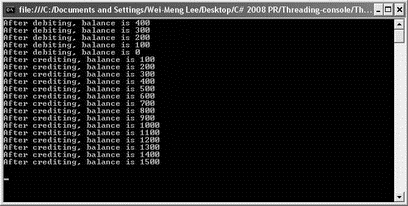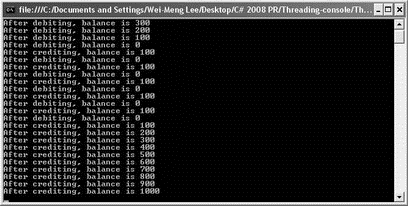Книга: C# 2008 Programmer
Monitor Class
Monitor Class
The limitation of the lock statement is that you do not have the capability to release the lock halfway through the critical section. This is important because there are situations in which one thread needs to release the lock so that other threads have a chance to proceed before the first thread can resume its execution.
For instance, you saw in Figure 10-6 that on the fifth line the balance goes into a negative value. In real life this might not be acceptable. The bank might not allow your account to go into a negative balance, and thus you need to ensure that you have a positive balance before any more debiting can proceed. Hence, you need to check the value of balance. If it is 0, then you should release the lock and let the crediting thread have a chance to increment the balance before you do any more debiting.
For this purpose, you can use the Monitor class provided by the .NET Framework class library. Monitor is a static class that controls access to objects by providing a lock. Here's a rewrite of the previous program using the Monitor class:
class Program {
//---used for locking---
static object obj = new object();
//---initial balance amount---
static int balance = 500;
static void Main(string[] args) {
Thread t1 = new Thread(new ThreadStart(Debit));
t1.Start();
Thread t2 = new Thread(new ThreadStart(Credit));
t2.Start();
Console.ReadLine();
}
static void Credit() {
//---credit 1500---
for (int i = 0; i < 15; i++) {
Monitor.Enter(obj);
balance += 100;
Console.WriteLine("After crediting, balance is {0}", balance);
Monitor.Exit(obj);
}
}
static void Debit() {
//---debit 1000---
for (int i = 0; i < 10; i++) {
Monitor.Enter(obj);
balance -= 100;
Console.WriteLine("After debiting, balance is {0}", balance);
Monitor.Exit(obj);
}
}
}
The Enter() method of the Monitor class acquires a lock on the specified object, and the Exit() method releases the lock. The code enclosed by the Enter() and Exit() methods is the critical section. The C# lock statement looks similar to the Monitor class; in fact, it is implemented with the Monitor class. The following lock statement, for instance:
lock (obj) {
balance -= 100;
Console.WriteLine("After debiting, balance is {0}", balance);
}
Is equivalent to this Monitor class usage:
Monitor.Enter(obj);
try {
balance -= 100;
Console.WriteLine("After debiting, balance is {0}", balance);
} finally {
Monitor.Exit(obj);
}
Now the code looks promising, but the debiting could still result in a negative balance. To resolve this, you need to so some checking to ensure that the debiting does not proceed until there is a positive balance. Here's how:
static void Debit() {
//---debit 1000---
for (int i = 0; i < 10; i++) {
Monitor.Enter(obj);
if (balance == 0) Monitor.Wait(obj);
balance -= 100;
Console.WriteLine("After debiting, balance is {0}", balance);
Monitor.Exit(obj);
}
}
When you use the Wait() method of the Monitor class, you release the lock on the object and enter the object's waiting queue. The next thread that is waiting for the object acquires the lock. If the balance is 0, the debit thread would give up control and let the credit thread have the lock.
However, this code modification may result in the scenario shown in Figure 10-7, in which after debiting the balance five times, balance becomes 0. On the sixth time, the lock held by the debit thread is released to the credit thread. The credit thread credits the balance 15 times. At that point, the program freezes. Turns out that the credit thread has finished execution, but the debit thread is still waiting for the lock to be explicitly returned to it.

Figure 10-7
To resolve this, you call the Pulse() method of the Monitor class in the credit thread so that it can send a signal to the waiting thread that the lock is now released and is now going to pass back to it. The modified code for the Credit() function now looks like this:
static void Credit() {
//---credit 1500---
for (int i = 0; i < 15; i++) {
Monitor.Enter(obj);
balance += 100;
if (balance < 0) Monitor.Pulse(obj);
Console.WriteLine("After crediting, balance is {0}", balance);
Monitor.Exit(obj);
}
}
Figure 10-8 shows that the sequence now is correct.

Figure 10-8
The complete program is as follows:
class Program {
//---used for locking---
static object obj = new object();
//---initial balance amount---
static int balance = 500;
static void Main(string[] args) {
Thread t1 = new Thread(new ThreadStart(Debit));
t1.Start();
Thread t2 = new Thread(new ThreadStart(Credit));
t2.Start();
Console.ReadLine();
}
static void Credit() {
//---credit 1500---
for (int i = 0; i < 15; i++) {
Monitor.Enter(obj);
balance += 100;
if (balance > 0) Monitor.Pulse(obj);
Console.WriteLine("After crediting, balance is {0}", balance);
Monitor.Exit(obj);
}
}
static void Debit() {
//---debit 1000---
for (int i = 0; i < 10; i++) {
Monitor.Enter(obj);
if (balance == 0) Monitor.Wait(obj);
balance -= 100;
Console.WriteLine("After debiting, balance is {0}", balance);
Monitor.Exit(obj);
}
}
}
- Monitoring a DNS server
- DebugPrint Monitor
- InterBase Classic Server под Linux
- Каталог BIN в InterBase Classic Server для Linux
- Classic
- Classic vs SuperServer
- Рекомендации по выбору архитектуры: Classic или SuperServer?
- Эффективное взаимодействие процессов архитектуры Classic Server
- Yaffil Classic Server - замена InterBase Classic 4.0
- SERVER PRIORITY CLASS
- CLASSIFY target
- CHAPTER 12 System-Monitoring Tools




